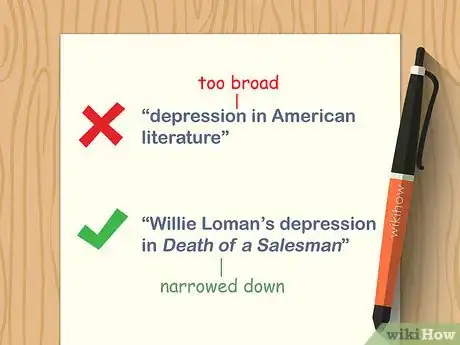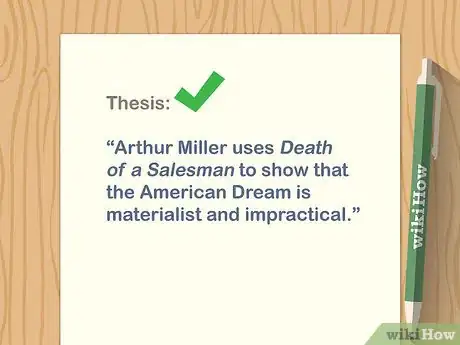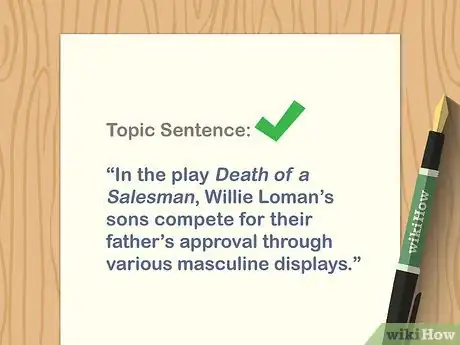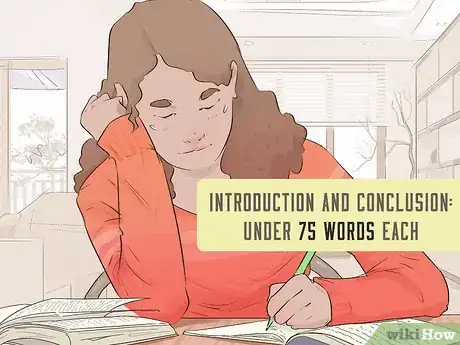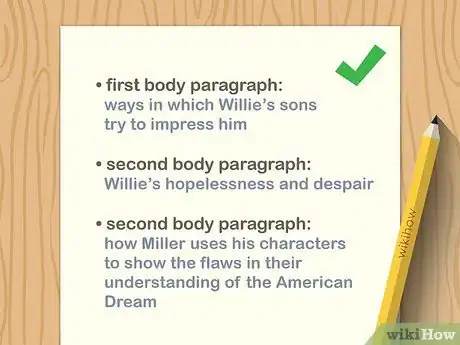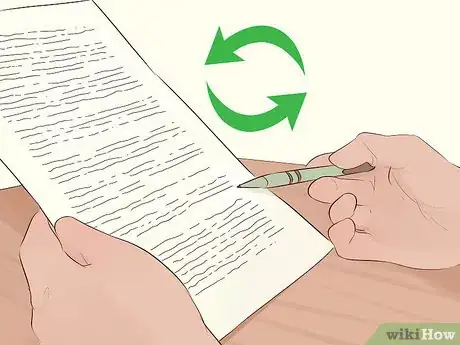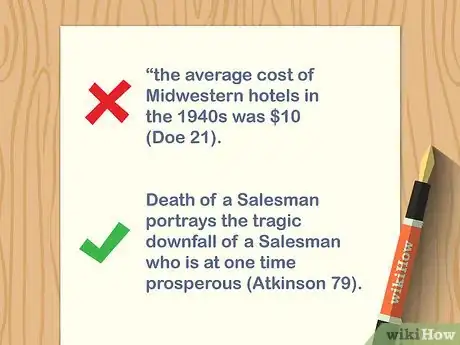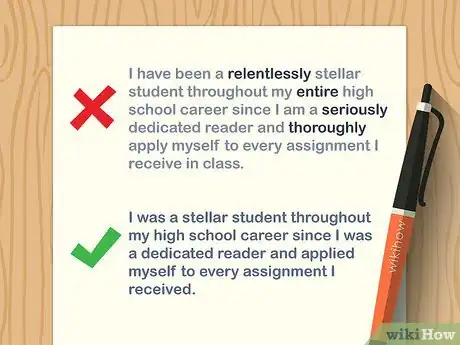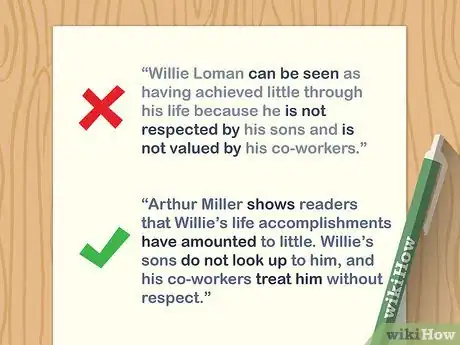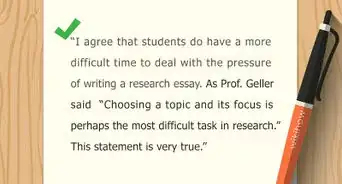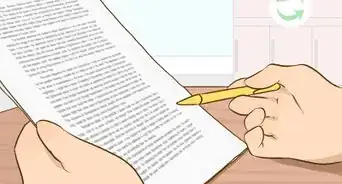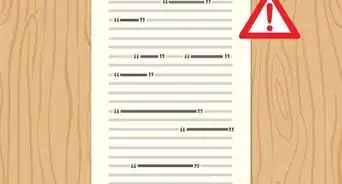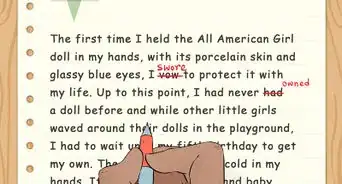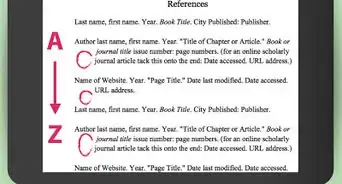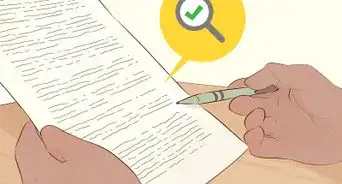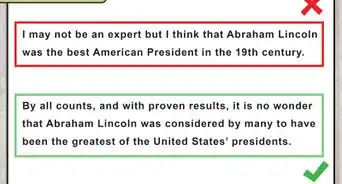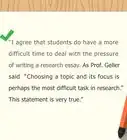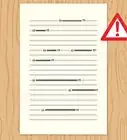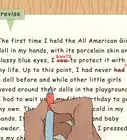This article was co-authored by Christopher Taylor, PhD. Christopher Taylor is an Adjunct Assistant Professor of English at Austin Community College in Texas. He received his PhD in English Literature and Medieval Studies from the University of Texas at Austin in 2014.
There are 13 references cited in this article, which can be found at the bottom of the page.
This article has been viewed 91,207 times.
Essay writing is a common assignment in high school or college courses, especially within the humanities. You’ll also be asked to write essays for college admissions and scholarships. In a short essay (250-500 words), you will need to provide an introduction with a thesis, a body, and a conclusion, as you would with a longer essay. Depending on the essay requirements, you may also need to do academic or online research to find sources to back up your claims.
Steps
Picking a Topic and Gathering Research
-
1Identify the topic by reading the prompt carefully. Underline important words and circle the question, if there is one. Make sure you fully understand what the prompt is asking you to write about so you can choose an effective argument.[1]
- If you have any questions about the topic, ask your instructor. If your essay doesn't respond to the prompt, you likely won't receive full credit.
-
2Choose a single arguable point for your brief essay. In a short essay, your writing will need to cohere around 1 central topic. You won’t have enough space to bring up tangentially related secondary topics. So, choose a narrow topic that you are interested in and can say something about, whether it's about an academic prompt or about yourself as a prospective college student. This will prevent the essay from growing to an impossibly large size.[2]
- If you're writing an essay for an in-class test or for an application, tailor the essay to the given prompt and topic. Quickly brainstorm a few ideas; for example, think of positive things you can say about yourself for a college-entrance essay.
- For example, the topic “depression in American literature” is far too broad. Narrow down your topic to something like “Willie Loman’s depression in Death of a Salesman.”
- Or, you could write about a narrow topic like “the increase in the USA’s national debt in the 1950s” rather than a broad topic like “the American economy in the 20th century.”
Advertisement -
3Find 1-2 appropriate secondary sources in an online research database. The majority of the research you’ll do for college or upper-level high school courses will take place online. Databases allow you to search through a large number of high-quality, peer-reviewed articles. In a short essay, you won’t have time to introduce more than 2 sources, and may find that it’s most effective to only use 1.
- Depending on the field in which you’re writing the essay—e.g., hard sciences, sociology, humanities, etc.—your instructor will direct you towards appropriate databases. For example, if you’re writing a high-school or college-level essay for your English class, visit online literary databases like JSTOR, LION, and the MLA Bibliography.
- If you're writing the essay for a college or graduate-school application, it's unlikely that you'll need to include any secondary sources.
- If you're writing a timed or in-class essay, you may not be able to find research articles. But, still do draw information from texts and sources you've studied both in and out of class, and build from points made in any provided reading passages.
-
4Use an article from a reliable website if your instructor allows it. Not all essay prompts permit online sources. If your particular prompt allows online sources, only use those that are objective and reliable. Focus on websites that end in .edu or .gov, as these will have no commercial bias.[3]
- If you’re writing about current events or journalism topics, read articles from well-known news sites like CNN or the BBC.
- Avoid citing unreliable websites like blogs or any sites that have a clear bias about the topic they’re reporting on.
Composing the Essay
-
1Create an outline for the short essay. Before you begin writing the essay, use an outline to plan out what you want to say in each of your paragraphs. Number your paragraphs 1–3 and jot down a phrase or sentence that sums up the major point you want to make in that paragraph. Also write down what secondary sources—if any—you’ll use in each paragraph.[4]
- If you write the essay without outlining, the essay will be poorly organized.
-
2Write a convincing, arguable thesis statement. A strong thesis statement is key to a short essay. The statement should sum up the argument or stance you plan to take in your essay. If the thesis statement is too vague, too obvious, or too weak, you’ll have a hard time focusing your argument around it.[5]
- This thesis statement is far too weak: “Death of a Salesman shows the difficulty of living in America after WWII.”
- Instead, hone your thesis to something like: “Arthur Miller uses Death of a Salesman to show that the American Dream is materialist and impractical.”
-
3Use your introduction paragraph to explain the essay’s topic. Start the paragraph by making a specific statement about the topic of the essay, so your argument can be sharpened and clarified from there. Concisely explain what the essay will discuss and why the topic is important. Also give readers an example of the type of evidence you’ll use to prove your point. Situate the thesis statement as the second or third sentence in your introductory paragraph, so readers will grasp your main point immediately.[6]
- So, avoid beginning the paragraph by writing something like, “Since the beginning of time, all people have been consumed with the desire for their father’s approval.”
- Instead, write something like, “In the play Death of a Salesman, Willie Loman’s sons compete for their father’s approval through various masculine displays."
- Then, you can say, "To examine this topic, I will perform a close reading of several key passages of the play and present analyses by noted Arthur Miller scholars."
-
4Keep the introduction and conclusion under 75 words each. It can be tempting to wax poetic in your introductory paragraph and to make abstract or theoretical statements about your chosen topic. Resist this temptation, and keep these paragraphs brief. The intro should contain no more than 6-7 sentences, and the conclusion only needs 3-4 sentences. The intro should explain the topic, give your thesis, and let readers know why the topic matters.[7]
- In a short essay, the conclusion should do nothing more than briefly restate your main claim and remind readers of the evidence you provided.
-
5Use body paragraphs to prove various aspects of your central argument. Every paragraph should contain and prove 1 main idea. You can prove the paragraphs' claim with a combination of quotes and citations from primary and secondary sources and your own thoughts and analyses. Keep in mind that all of the claims you make should work to prove your thesis in one way or another.[8]
- So, take the example about Death of a Salesman. The first body paragraph could discuss the ways in which Willie’s sons try to impress him.
- The second body paragraph could dive into Willie’s hopelessness and despair, and the third paragraph could discuss how Miller uses his characters to show the flaws in their understanding of the American Dream.
-
6Add information from your research sources to strengthen claims. Inserting 1-2 quotations or pieces of data from research articles shows that you’re aware of conversations surrounding your topic.[9] Make sure to keep the quotes or data summaries brief, focused, and to the point so you don’t exceed the word count.
- Always cite your sources so you avoid charges of plagiarism. Check with your instructor (or the essay prompt) and find out what citation style you should use.
- For example, if you’re summarizing the inflation of the American dollar during the 1930s, provide 2 or 3 years and inflation-rate percentages. Don’t provide a full-paragraph summary of the economic decline.
- If you're writing an in-class essay and don't have time to perform any research, you don't need to incorporate outside sources. But, it will impress your teacher if you quote from a reading passage or bring up pertinent knowledge you may have gained during the class.
-
7Ask someone else to read your first draft. It’s hard for writers to spot their own mistakes and errors, whether grammatical or structural. So, ask a friend, classmate, or even your instructor to look over your rough draft.[10] Ask them to give you constructive criticisms and point out any parts of your essay that didn’t make sense.
- If no one agrees to read the essay, read over your own first draft and look for errors or spots where you could clarify your meaning. Reading the essay out loud often helps, as you’ll be able to hear sentences that aren’t quite coherent.
- This step does not apply to essays written during a timed or in-class exam, as you won't be able to ask peers to read your work.
-
8Revise the first draft into the final essay. Once you’ve received helpful feedback on your rough draft, incorporate the suggestions into a final draft. Revise any errors and look for ways to strengthen your overall argument.[11] Avoid the temptation to just fix surface-level errors. For example, you may need to add a new paragraph or completely rewrite the introduction.
- It’s always a mistake to submit an unrevised first draft, whether for a grade, for admissions, or for a scholarship essay.
- However, if you're writing an essay for a timed exam, it's okay if you don't have enough time to combine multiple drafts before the time runs out.
Condensing Your Essay
-
1Quote only from secondary sources that are related to your topic. When you’re finding sources for the short essay, weed out any unnecessary sources so that you don’t become overwhelmed. Only cite sources that directly inform the topic you want to address. If you’re unsure about which sources are relevant, or which types of sources you should be gathering, talk with your instructor.[12]
- So, if you’re writing about Death of a Salesman, an article about symbolism in Arthur Miller’s plays would be useful. But, an article about the average cost of Midwestern hotels in the 1940s would be irrelevant.
- If you’re writing a scholarship essay, double-check the instructions to clarify what types of sources you’re allowed to use.
-
2Remove verbiage to keep your essay under the word count. Especially when writing a college application essay, it’s crucial that you stay within the word count. Cut extra words and information that isn’t strictly necessary. Remove adverbs, adjectives, and lengthy verb phrases, as well as cliches and generalizations.[13]
- A common cliche you might find in an essay is a statement like, "I'm the hardest working student at my school."
- For example, this sentence is too verbose: “I have been a relentlessly stellar student throughout my entire high school career since I am a seriously dedicated reader and thoroughly apply myself to every assignment I receive in class.”
- Shortened, it could read: “I was a stellar student throughout my high school career since I was a dedicated reader and applied myself to every assignment I received.”
-
3Write short sentences in the active voice. Writing in the active voice will help you keep your sentences succinct and to the point. Write sentences that express an idea clearly and directly. To keep your sentences brief, begin most sentences with the subject (the person or thing performing an action) and the action they perform, rather than describing how an object is acted upon.[14]
- Avoid writing something like, “Willie Loman can be seen as having achieved little through his life because he is not respected by his sons and is not valued by his co-workers.”
- Instead, write, “Arthur Miller shows readers that Willie’s life accomplishments have amounted to little. Willie’s sons do not look up to him, and his co-workers treat him without respect.”
-
4Present only the most relevant argument in your essay. If you’re passionate about your essay topic, you may feel inclined to include multiple arguments relating to multiple facets of the topic. However, this will almost certainly put you over the word count. To avoid this problem, include only the best evidence supporting your strongest claim.[15]
- For example, if you’re trying to prove that WWII pulled the USA out of the Great Depression, focus strictly on an economic argument.
- Avoid bringing in other, less convincing topics. For example, don’t dedicate a paragraph to discussing how much it cost the USA to build fighter jets in 1944.
References
- ↑ https://owl.purdue.edu/owl/general_writing/common_writing_assignments/research_papers/choosing_a_topic.html
- ↑ https://monroecollege.libguides.com/c.php?g=589208&p=4072926
- ↑ https://www.utep.edu/extendeduniversity/utepconnect/blog/march-2017/4-ways-to-differentiate-a-good-source-from-a-bad-source.html
- ↑ https://www.grammarly.com/blog/essay-outline/
- ↑ https://writingcenter.unc.edu/tips-and-tools/thesis-statements/
- ↑ https://libguides.newcastle.edu.au/how-to-write-an-essay/essay-introduction
- ↑ https://lsa.umich.edu/sweetland/undergraduates/writing-guides/how-do-i-write-an-intro--conclusion----body-paragraph.html
- ↑ https://lsa.umich.edu/sweetland/undergraduates/writing-guides/how-do-i-write-an-intro--conclusion----body-paragraph.html
- ↑ https://writingcenter.fas.harvard.edu/pages/essay-structure
- ↑ https://mlpp.pressbooks.pub/writingsuccess/chapter/8-3-drafting/
- ↑ https://mlpp.pressbooks.pub/writingsuccess/chapter/8-3-drafting/
- ↑ https://www.trentu.ca/academicskills/how-guides/how-write-university/how-approach-any-assignment/writing-english-essay/using-secondary
- ↑ https://patch.com/michigan/berkley/bp--how-to-shorten-your-college-essay-without-ruining-it
- ↑ https://writing.wisc.edu/handbook/style/ccs_activevoice/
- ↑ https://wordcounter.net/blog/2016/01/26/101025_how-to-reduce-essay-word-count.html
